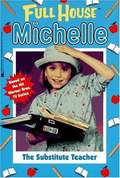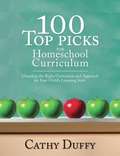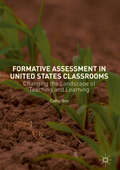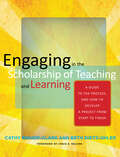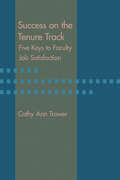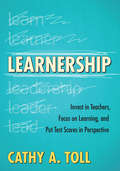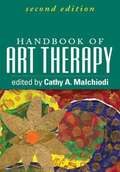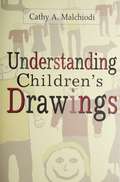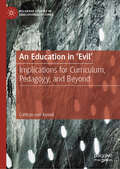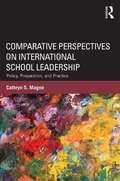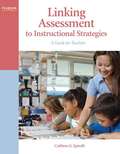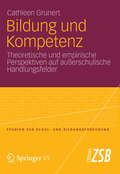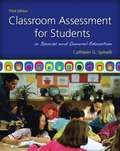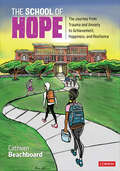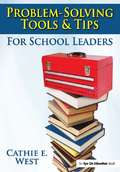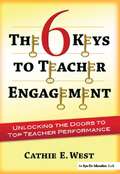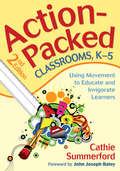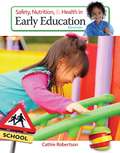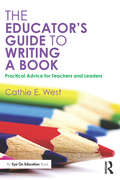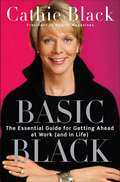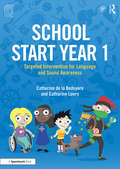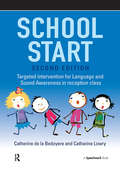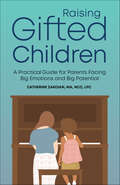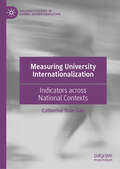- Table View
- List View
The Substitute Teacher (Full House Dear Michelle)
by Cathy East Dubowski"Our substitute teacher quit- because of me!" Michelle and her friends can't wait to go to class. They have a substitute teacher-and that means fun, fun, fun! Michelle's friends know a ton of pranks and tricks to play on subs, and they plan to try them all. Everyone is having a great time--until the sub quits and puts Michelle in charge of the class. Now Michelle is the substitute. What is she going to do?
100 Top Picks for Homeschool Curriculum: Choosing the Right Curriculum and Approach for Your Child's Learning Style
by Cathy DuffyA critical volume for the homeschooling community that helps parents make informed choices regarding learning styles and curriculum.
Formative Assessment in United States Classrooms: Changing the Landscape of Teaching and Learning
by Cathy BoxThis book examines the history of formative assessment in the US and explores its potential for changing the landscape of teaching and learning to meet the needs of twenty-first century learners. The author uses case studies to illuminate the complexity of teaching and the externally imposed and internally constructed contextual elements that affect assessment decision-making. In this book, Box argues effectively for a renewed vision for teacher professional development that centers around the needs of students in a knowledge economy. Finally, Box offers an overview of systemic changes that are needed in order for progressive teaching and relevant learning to take place.
Engaging in the Scholarship of Teaching and Learning: A Guide to the Process, and How to Develop a Project from Start to Finish
by Beth Dietz-Uhler Cathy Bishop-ClarkThis is a book for anyone who has ever considered engaging in the scholarship of teaching and learning – known familiarly as SoTL – and needs a better understanding of what it is, and how to engage in it. The authors describe how to create a SoTL project, its implications for promotion and tenure, and how it fosters:* Increased satisfaction and fulfillment in teaching* Improved student learning* Increased productivity of scholarly publication* Collaboration with colleagues across disciplines* Contributing to a growing and important body of literatureThis guide provides prospective SoTL scholars with the necessary background information, foundational theory, tools, resources, and methodology to develop their own SoTL projects, taking the reader through the five stages of the process: Generating a research question; Designing the study; Collecting the data; Analyzing the data; and Presenting and publishing your SoTL project. Each stage is illustrated by examples of actual SoTL studies, and is accompanied by worksheets to help the reader refine ideas and map out his or her next steps. The process and worksheets are the fruit of the successful SoTL workshops the authors have offered at their institution for many years. SoTL differs from scholarly and reflective teaching in that it not only involves questioning one’s teaching or a teaching strategy, but also formally gathering and exploring evidence, researching the literature, refining and testing practices, and finally going public. The purpose of SoTL is not just to make an impact on student learning, but through formal, peer-reviewed communication, to contribute to the larger knowledge base on teaching and learning. While the roots of SoTL go back some 30 years, it was Ernest Boyer in his classic Scholarship Reconsidered who made the case for the parity of the scholarships of integration, of discovery, of application, and of scholarship of teaching as vital to the health of higher education. Glassick, Huber, and Maeroff ’s subsequent Scholarship Assessed articulated the quality standards for SoTL, since when the field has burgeoned with the formation of related associations, a proliferation of conferences, the launching of numerous journals, and increasing recognition and validation by institutions.
Success on the Tenure Track: Five Keys to Faculty Job Satisfaction
by Cathy Ann TrowerSatisfaction ratings from tenure-track faculty at 200 institutions across the country reveal best practices and the key elements of workplace success.Landing a tenure-track position is no easy task. Achieving tenure is even more difficult. Under what policies and practices do faculty find greater clarity about tenure and experience higher levels of job satisfaction? And what makes an institution a great place to work?In 2005–2006, the Collaborative on Academic Careers in Higher Education (COACHE) at the Harvard Graduate School of Education surveyed more than 15,000 tenure-track faculty at 200 participating institutions to assess their job satisfaction. The survey was designed around five key themes for faculty satisfaction: tenure clarity, work-life balance, support for research, collegiality, and leadership. Success on the Tenure Track positions the survey data in the context of actual colleges and universities and real faculty and administrators who talk about what works and why. Best practices at the highest-rated institutions in the survey—Auburn, Ohio State, North Carolina State, Illinois at Urbana-Champaign, Iowa, Kansas, and North Carolina at Pembroke—give administrators practical, proven advice on how to increase their employee satisfaction. Additional chapters discuss faculty demographics, trends in employment practices, what leaders can do to create and sustain a great workplace for faculty, and what the future might hold for tenure.An actively engaged faculty is crucial for American higher education to retain its global competitiveness. Cathy Ann Trower’s analysis provides colleges and universities a considerable inside advantage to get on the right track toward a happy, productive workforce.
Learnership: Invest in Teachers, Focus on Learning, and Put Test Scores in Perspective
by Cathy A. TollPut the focus of education back where it belongs—on learning! Do you feel bogged down by endless administrative tasks? Do you wish you could focus more on what truly matters—learning? Learnership provides both insight and solutions for moving past distractions and becoming a learning leader. Cathy Toll illustrates how the practice of learnership can be implemented every day through activities, real-life stories, and narrative bibliography. This book offers: Practices to help teachers improve their effectiveness using problem-solving techniques; More effective ways to approach data, testing, and accountability; Strategies for supporting Professional Learning Teams (PLT) and educational coaches.
Handbook of Art Therapy, Second Edition
by Cathy A. MalchiodiWidely regarded as the standard reference in the field, this handbook provides a complete overview of art therapy, from theory and research to practical applications. Leading practitioners demonstrate the nuts and bolts of arts-based intervention with children, adults, families, couples, and groups dealing with a wide range of clinical issues. Rich with illustrative case material, the volume features 110 sample drawings and other artwork. The inclusion of diverse theoretical approaches and practice settings makes the Handbook eminently useful for all mental health professionals interested in using art in evaluation and treatment. New to This Edition Incorporates the latest clinical applications, methods, and research. Chapter on art materials and media (including uses of new technologies). Chapters on intervening with domestic violence survivors, bereaved children, and military personnel. Expanded coverage of neuroscience, cultural diversity, and ethics.
Understanding Children's Drawings
by Cathy A. MalchiodiThis practical resource demonstrates how all clinicians can broaden and enhance their work with children by integrating drawing into therapy. The book enables therapists to address the multidimensional aspects of children's art without resorting to simplistic explanations. Approaching drawing as a springboard for communication and change, Malchiodi offers a wealth of guidelines for understanding the intricate messages embedded in children's drawings and in the art-making process itself. Topics covered include how to assist children in making art, what questions to ask and when, and how to motivate children who are initially resistant to drawing. Assimilating extensive research and clinical experience, the book includes over 100 examples of children's work.
An Education in 'Evil': Implications for Curriculum, Pedagogy, and Beyond (Palgrave Studies in Educational Futures)
by Cathryn van KesselThis book asserts that engaging with divergent understandings about the nature of evil and how it functions can help those interested in education think through issues in curriculum, pedagogy, and beyond. The author provokes thinking about and through the concept of evil in the spirit of thoughtful education (as opposed to thoughtless schooling) toward how we might live together in less harmful ways. Although thinking about evil can be uncomfortable and troubling, such inquiries help us explore what sort of relations we want to have with others. Analyzing our role in evil as humans, as well as our responsibilities to counter the processes of evil present in our everyday lives, opens up a potential to foster radical thought in and out of the classroom.
Comparative Perspectives on International School Leadership: Policy, Preparation, and Practice
by Cathryn S. MagnoThrough a multi-country study, Comparative Perspectives on International School Leadership examines the current global spread of educational leadership, occurring rapidly and widely. Exploring five international case studies of leadership policy, preparation, and practice under the framework of policy borrowing and adaptation, Magno attempts to understand and account for commonalities and differences across country contexts. Rather than assuming a particular model or theory to leadership is best, Comparative Perspectives on International School Leadership takes a policy-oriented perspective and considers how and why certain approaches are being formulated and accepted, including an examination of motivations, influencers, actors, institutions, and implementation processes. Magno ultimately argues that efforts toward formalizing educational leadership reflect current global political objectives to improve schools by increasing accountability, transparency, and professionalism. This engaging book will be of interest to scholars and students in the fields of educational leadership and comparative education.
Linking Assessment to Instructional Strategies: A Guide for Teachers
by Cathleen SpinelliThis practical, teacher-friendly book provides step-by-step instructions on choosing and administering classroom assessments; analyzing, interpreting, rating, and monitoring results; and reporting student progress. Whether new to authentic or informal assessment, or strongly familiar with traditional testing, this book will interpret and guide the teaching professional on how to integrate cutting-edge assessment measures seamlessly into their daily teaching schedule. The book is chock-full of the latest in authentic, curriculum and performance-based assessment measures with direct connections to instruction, IEP development, and methods of reporting to parents. Busy teachers will appreciate the clear, accessible writing style and how easily the book helps them to determine what test to use, the specific diagnostic questions to ask, the classroom materials that will be needed, clearly informed administration strategies, and the explicit examples that are included and can be taken straight from the page to the real classroom. Keenly focused on providing teachers with a variety of assessment procedures, including the why, what, and how of testing, it furthermore gives directions on how to construct, administer, and score assessments as well as how to interpret, graph, monitor, write, and report assessment results to families and school support personnel. Another key feature includes suggested interventions to use when test results indicate that specific skills have been mastered, are emerging, or need to be introduced. An ideal book for school administrators, supervisors, and remedial specialists, and for those implementing Response to Intervention (RI), it is most appropriate for professional development and in-service practicing teachers who want an easy-to-read and useful guide to state-of-the-art, best practices in assessment.
Bildung und Kompetenz: Theoretische und empirische Perspektiven auf außerschulische Handlungsfelder (Studien zur Schul- und Bildungsforschung #44)
by Cathleen GrunertBildung und Kompetenz als Begriffskonstruktionen werden im öffentlichen Diskurs, aber oft auch auf wissenschaftlichem Terrain vor allem mit schulischen Formen des Lernens in Verbindung gebracht. Dementsprechend sind empirische Forschungen im Kontext "Empirischer Bildungsforschung" aktuell stark schulbezogen und in ihren theoretischen Bezügen auf die Begriffe von Bildung und Kompetenz meist einseitig produktbezogen. Empirische Untersuchungen, die theoretisch und methodisch begründet nach der Rolle außerschulischer Handlungsfelder für die Lern- und Bildungsprozesse von Kindern und Jugendlichen fragen, sind aktuell jedoch vergleichsweise selten. In diesem Buch wird im Anschluss an eine Analyse der beiden zentralen Begriffe von Bildung und Kompetenz und ihrer Verschränkungen sowie eine kritische Sichtung des aktuellen nationalen und v.a. us-amerikanischen Forschungsstand danach gefragt, wie man sich diesem Feld in theoretischer und methodischer Perspektive nähern kann. Dafür wird auf den Ansatz der activity theory zurückgegriffen, der sowohl einen theoretischen als auch einen forschungsheuristischen Rahmen bietet, um sich dieses Feld in seiner Komplexität erschließen zu können.
Classroom Assessment for Students in Special and General Education (Third Edition)
by Cathleen G. SpinelliClassroom Assessment for Students in Special and General Education is written for future teachers and experienced educators who are interested in developing or expanding their understanding of effective and reflective assessment practices. This new edition, with its emphasis on progress monitoring and early intervention, aligns well with the practical, authentic, and informal assessment procedures that have been--and continue to be--the heart of this edition and of past editions of this text.
The School of Hope: The Journey From Trauma and Anxiety to Achievement, Happiness, and Resilience
by Cathleen BeachboardDiscover how to improve achievement, happiness, and resilience using the science of hope The current mental health crisis is driving many teachers to leave the profession while students struggle with engagement and anxiety. Trauma-informed coping mechanisms are helpful, but this book goes a step further by incorporating much-needed but often-missing support to help learners feel hopeful and provide educators with resources to care for themselves. Based on research around the psychological science of hope, this guidebook provides strategies educators and school leaders can use daily to help students feel secure, build relationships, and improve academic outcomes. Included are practices and interventions that can be woven into classrooms and schools to foster mental wellness and happiness using Classroom materials, tools, and reproducibles Scientific resources to quickly assess and monitor hope Simple plans of action to improve hope, engagement, and motivation Vignettes from classrooms and the author’s own experiences with children who have experienced extreme trauma Backed by the latest research, The School of Hope will encourage higher academic attainment and equity, inspiring a sense of deeper fulfillment for both students and educators.
The School of Hope: The Journey From Trauma and Anxiety to Achievement, Happiness, and Resilience
by Cathleen BeachboardDiscover how to improve achievement, happiness, and resilience using the science of hope The current mental health crisis is driving many teachers to leave the profession while students struggle with engagement and anxiety. Trauma-informed coping mechanisms are helpful, but this book goes a step further by incorporating much-needed but often-missing support to help learners feel hopeful and provide educators with resources to care for themselves. Based on research around the psychological science of hope, this guidebook provides strategies educators and school leaders can use daily to help students feel secure, build relationships, and improve academic outcomes. Included are practices and interventions that can be woven into classrooms and schools to foster mental wellness and happiness using Classroom materials, tools, and reproducibles Scientific resources to quickly assess and monitor hope Simple plans of action to improve hope, engagement, and motivation Vignettes from classrooms and the author’s own experiences with children who have experienced extreme trauma Backed by the latest research, The School of Hope will encourage higher academic attainment and equity, inspiring a sense of deeper fulfillment for both students and educators.
Problem-Solving Tools and Tips for School Leaders: Tools And Tips For School Leaders
by Cathie WestIn this book, award-winning educator Cathie West teaches readers how to confidently prepare for and respond to the challenges that come with being a school leader. Derived from professional experience and extensive research, the strategies can be put to work exactly as described or adapted to fit the unique situations that educators face in their schools. With more than thirty years of experience as a school principal, West provides tips for teacher leaders striving to expand their skills, brand new administrators looking for guidance, and experienced principals confronting the unfamiliar or looking for fresh problem-solving ideas.
The 6 Keys to Teacher Engagement: Unlocking the Doors to Top Teacher Performance
by Cathie WestIn her new book, award-winning principal and leadership expert Cathie West provides education leaders at all levels with the tools and guidance they need to engage teachers in the process of increasing student achievement. With authentic examples and research highlights, readers learn how to develop a motivated faculty that is truly dedicated to school improvement and student success. The "Six Keys" covered in the book are both substantive and comprehensive and offer a clear path to success: Key 1: Create a Culture of Engagement Teacher engagement definition, attributes, and steps towards attainment Key 2: Get Organizationally Engaged Exemplary organization qualities, leadership styles, and effectiveness strategies Key 3: Engineer Engagement Quality meeting characteristics, engagement activities, and leadership techniques Key 4: Zero in on Best Practice Effective teaching attributes, instructional practices, and success tips Key 5: Tap into Teacher Leaders Teacher leader selection, training, and strategic deployment Key 6: Confront Change Challengers Challenger profiles, interventions, and support suggestions BONUS! Every chapter includes a wrap-up to help readers review, apply, and retain new learning for each of the six keys to teacher engagement: Key Concepts provides a bulleted summary of each theme’s major concepts to help readers review key ideas. Best Strategies summarizes each chapter’s high impact teacher engagement strategies. Steps to Success suggests activities that will move new concepts and skills into practice. NOTEWORTHY: This book is also an excellent resource for university and college instructors who are responsible for teacher and principal preparation. The 6 Keys to Teacher Engagement substantially supports graduate level courses pertaining to educational leadership, school improvement, curriculum and assessment, and professional development.
Action-Packed Classrooms, K-5: Using Movement to Educate and Invigorate Learners
by Cathie SummerfordUse movement and music to stimulate children’s ability to absorb and retain new information! Focusing on using movement and music to energize young students and boost their learning, this research-based book offers strategies for basic energizers, clear objectives for standards-aligned instruction, and a student/teacher/principal agreement to commit to active learning. Showing how exciting and fun learning can be, this new edition: Includes new chapters on planning and organizing lessons Offers sample activities in math, social studies, science, language arts, health, and physical education Provides tools for assessing the effectiveness of activities Presents updated brain research
Safety, Nutrition, Health in Early Education
by Cathie RobertsonSAFETY, NUTRITION, AND HEALTH IN EARLY EDUCATION uses theory, practical applications, and resources to prepare readers for a career in working with children from birth to age eight in multicultural and socioeconomically diverse early childhood settings. This book emphasizes healthy development, including environmental health and safety, active supervision, and how issues surrounding safety, nutrition, health, child maltreatment, and mental and emotional health can affect brain development. It also fully integrates NAEYC, DAP, and AAP/APHA professional standards throughout, and includes strategies for how to engage diverse families from various backgrounds and beliefs, and also those whose children have special needs.
The Educator's Guide to Writing a Book: Practical Advice for Teachers and Leaders
by Cathie E. WestThe Educator’s Guide to Writing a Book is for educators who dream of sharing their knowledge and skills with a broader audience. This exciting resource provides step-by-step guidance on how to set publishing goals, create well-written content and resource material, develop an informative yet accessible writing style, prepare professional level manuscripts, and anticipate each stage in the publishing process. Chapters include authentic writing examples, tips from veteran authors and publishing professionals, and supportive resources. The Educator’s Guide to Writing a Book is an invaluable guide that helps aspiring and novice authors move publishing goals from dreams to reality. .
Basic Black: The Essential Guide for Getting Ahead at Work (and in Life)
by Cathie BlackCathie Black is the wise, funny mentor that every woman dreams of having. She was a pioneer in advertising sales at a time when women didn't sell; served as president and publisher of the fledgling "USA Today"; and, in her current position as the president of Hearst Magazines, persuaded Oprah to launch a magazine.<P> In 2006 she was named one of Fortune's "50 Most Powerful Women in American Business" for the seventh consecutive year. Now, in the exuberant, down-to-earth voice that is her trademark, Cathie explains how she achieved "the 360 degree life"--a blend of professional accomplishment and personal contentment--and how any woman can seize opportunity in the workplace.<P> No matter where you are in your career, "Basic Black" offers invaluable lessons that will help you land the job, promotion, or project you're vying for. At the core of the book are Cathie's candid, personal stories. She walks us through her decision to risk dropping a huge ad agency that handled the "USA Today" campaign in favor of a small boutique agency run by a wild man. (It was a smash.) She admits that her sometimes brusque style once led to a mutiny of staffers at Ms. (She learned to be more flexible in her managerial style.) She offers a clear-eyed look at what happened during the twenty-eight months between the launch and the close of the much-buzzed-about "Talk" magazine. And throughout, she offers fascinating glimpses of media and business personalities, such as Rupert Murdoch, Tina Brown, Frank Bennack, Vic Ganzi, former "CosmoGirl!" editor Atoosa Rubenstein, Bonnie Fuller, and the legendarily difficult Al Neuharth, founder of "USA Today".<P> Above all, "Basic Black" is motivating. It provides a close-up look at the keen judgment, perseverance, and optimism that have propelled Cathie Black to the top of her game, along with the kind of straight-up practical advice you get in a one-on-one session with a career coach. You'll find out how to handle job interviews, which rules to break, and why you should make your life a grudge-free zone. Equally important, you'll be inspired to pursue your passions and achieve your very best.
School Start Year 1: Targeted Intervention for Language and Sound Awareness (School Start)
by Catherine de la Bedoyere Catharine LowryThis highly practical resource is designed to be used with children who need additional help in developing communication skills in Year 1. It offers a carefully structured group intervention which can be delivered by teachers or teaching assistants and is designed to boost language and sound awareness skills School Start Year 1 includes: detailed advice on how to set up the programme and identify children who may benefit; a structured programme of 30 Language group sessions; a structured programme of 30 Sound Awareness group sessions; activities and learning objectives that link with the Primary curriculum; 56 resource templates that can be photocopied or downloaded from the website; templates to monitor each child’s objectives and an end of year evaluation. Activities are supported by colourful and original illustrations to engage children’s interest and are themed around topics such as animal antics, detective stories and the seaside. An additional 5 template sessions are provided which can be used to extend the programme into Year 2. The authors provide clear guidance on how to use the resources and include an FAQ section for schools, parents and Speech and Language Therapists. This latest resource is a follow on to the hugely popular School Start and Pre-School Start and has been successfully piloted in schools. This is an invaluable resource for primary school staff that encourages good collaborative practice between teachers, teaching assistants, inclusion co-ordinators, SENCOs, speech and language therapists and parents.
School Start: Targeted Intervention for Language and Sound Awareness in Reception Class, 2nd Edition (School Start)
by Catherine de la Bedoyere Cath LowryThis is a practical resource that can be used with children who need additional help in developing communication skills during the first year of school and is a follow-on from the hugely successful first edition. This second edition focuses primarily on a targeted group intervention, to boost the language and sound awareness skills of children entering reception class, who are delayed in these areas of communication. It also addresses aspects of attention, following instructions and social communication.School Start, aims to help children catch up so that they may be ready to access the learning environment of Year 1. It is an invaluable resource for teachers and teaching assistants that encourages good collaborative practice between schools, speech & language therapists, the SENCO and parents. The programme consist of: an initial six-week period so that educational staff may identify children of concern; a screening checklist to confirm the identification of those children a structured programme of 30 Language group sessions that teaching assistants will find quick and easy to follow, delivered once a week a structured programme of 30 Sound Awareness group sessions that teaching assistants will find quick and easy to follow, delivered once a week activities and learning objectives linked into communication at home and in class monitoring of each child's objectives and readministration of the checklist in July. Teachers and teaching assistants first select children suitable for the programme through the checklists provided; set-up meetings then take place between the inclusion coordinator and school before the child is enrolled on the programme. Devised by two speech & language therapists experienced in working with teaching staff, the book consists of two 30-week programmes aimed at developing Language and Sound Awareness skills. Each six-week block has clearly written objectives that are linked to the National Curriculum Foundation Stage. Baseline and evaluation checklists are also provided to monitor each child's progress.School Start offers: an introduction on how to use the School Start programme group sessions for the Language and Sound Awareness programmes 70 photocopiable resource templates programme delivery templates containing all the checklists, record sheets and handouts needed to carry out the programme an accompanying CD-Rom giving the option to print out some of the resource templates in colour. Successfully trialled over a three-year period, School Start is an invaluable resource for teachers and teaching assistants that encourages good collaborative practice between schools, speech & language therapists, the school's inclusion coordinator and parents.
Raising Gifted Children: A Practical Guide for Parents Facing Big Emotions and Big Potential
by Catherine ZakoianRaise a happier, healthier gifted child—practical tools and advice for parentsGifted children can be identified as perplexing or troublesome long before they're identified as gifted. Many of the traits that characterize challenging gifted behaviors—such as intensity, sensitivity, and perfectionism—are simply shadows cast by a bright light within. Raising Gifted Children is filled with insights, guidance, up-to-date research, and practical advice to help parents better understand the inner world of their gifted child so they can help them flourish at home, school, and beyond.You'll start by learning the fundamentals of giftedness, from its characteristics to its strengths and challenges. Then, discover how to put your child's social-emotional and mental wellbeing at the center of resolving issues with conflict, procrastination, and motivation. You'll find information on how to navigate schooling to help find the best fit for your child, as well as advice for encouraging them to develop meaningful friendships.Raising Gifted Children includes:Understanding giftedness—Learn what defines giftedness, how it's expressed, and helpful info about twice- and multi-exceptionality.Parenting tools—Develop strategies for addressing your gifted child's emotional intensity, communicating effectively, and reflecting to find calm.Schooling strategies—Explore advice for school choice for your child, including homeschool, as well as tips for successful teacher meetings and creating educational plans.Be a strong, supportive parent to your gifted child with the essential guidance in this book.
Measuring University Internationalization: Indicators across National Contexts (Palgrave Studies in Global Higher Education)
by Catherine Yuan GaoThis book investigates university internationalization in different national contexts and compares internationalization performance across national boundaries. Internationalization has been recognised by policymakers as the key to perform successfully within the new global context: the author identifies primary motivations for universities to embrace this agenda, and deconstructs the phenomenon into measurable dimensions and components. Using extensive qualitative data from university leaders and practitioners, this book analyses the global forces that shape the international education landscape, and reviews the existing instruments for measuring internationalization. In doing so, the author proposes an integrated understanding of university internationalization and indicates benchmarks that can help to quantify and measure this phenomenon. This book will be of interest and value to students and scholars of university internationalization.
